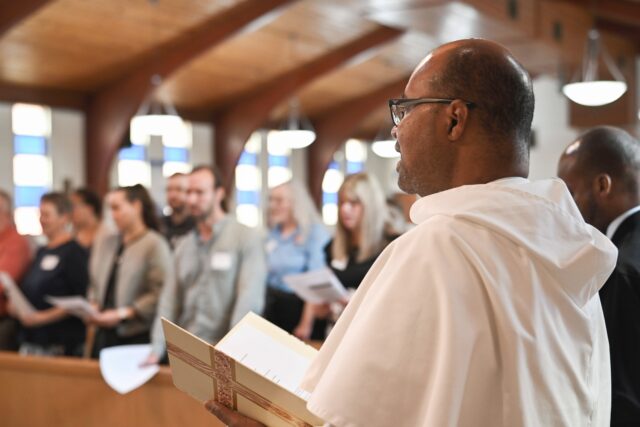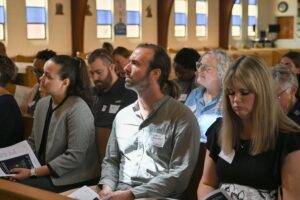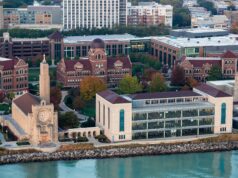
ATLANTA — Lawyers, former inmates and leaders of justice reform were among the nearly 140 participants who attended a restorative justice conference rooted in Catholic social teaching.
Advocates from across the country shared “collective wisdom” to bring the concept back to their communities
“We think there are ways that the Catholic Church can help to usher in hope and healing into our prison system, for people on the inside, for people who are reentering society, for people who have been victims of harm,” said Krisanne Vaillancourt Murphy, the executive director of Catholic Mobilizing Network. “We think the church can be a beacon of hope.”
During the three-day gathering at Emory University in Atlanta, participants in the National Catholic Conference on Restorative Justice toured the historic Ebenezer Baptist Church, immersing themselves in the legacy of the Rev. Dr. Martin Luther King Jr., before praying at Our Lady of Lourdes Catholic Church. Later, they attended Mass celebrated by Atlanta Archbishop Gregory J. Hartmayer.
The conference aimed to “advance healing approaches to harm, crime and injustice.” A project of the Catholic Mobilizing Network, the event was held in collaboration with the Archdiocese of Atlanta and the Aquinas Center of Theology at Emory University’s Candler School of Theology.
Formed around the theme of “Tangible Signs of Hope” by conference organizers, the Sept. 25-27 event was linked to the church’s Jubilee Holy Year that takes place every 25 years and focuses on reconciliation and renewal.
Reforming the legal system “honors the dignity of every person, someone who has caused harm, someone who has suffered from harm,” said Vaillancourt Murphy. “We just want to bring about change that is about reconciliation and healing.”
The traditional justice system focuses on the laws that have been broken, while the practice of restorative justice centers on the person or persons who have been harmed, said Jayna Hoffacker, who serves as the director of restorative justice ministry at the Archdiocese of Atlanta.
“As Catholics, we care about the dignity of the human person, and restorative justice at its core is about respecting the dignity of all people without reserve,” said Hoffacker.
The primary goal in conventional justice is punishment and deterrence. Restorative justice, meanwhile, considers the harm done and in a safe and structured process brings together the victim, the offender and a community representative to promote healing and accountability, and restoring the community, said Hoffacker.
At the Mass for the conference, Archbishop Hartmayer reminded the conference attendees that their mission is to serve as beacons of hope.
“We know only too well that restorative justice is not a quick fix. It asks us to walk into the pain of others, to face wounds that run deep, and to believe — even when it is costly — that mercy has the last word,” said the archbishop.
Attendees saw these concepts put into practice at a panel titled “Lessons Learned in 15 Years: Two Families’ Restorative Justice Journey.” Here, two couples shared how their lives were forever changed when Ann Grosmaire was shot and killed by her boyfriend Conor McBride. The Grosmaire and McBride parents lived Holy Week 2010 — from the shooting on Palm Sunday to the decision to remove Ann’s life support on Good Friday.

“Thank you for being here,” Deacon Andy Grosmaire told Michael McBride when they met at the hospital with Ann in the ICU the day of the shooting. “But I might hate you by the end of the week.”
Through the grief and pain, the couples felt called by faith to find peace through the restorative justice process. It would help them get answers and hold Conor more accountable for his actions than the traditional court system alone.
Deacon Grosmaire recounted a spiritual experience beside his daughter’s hospital bed.
“It was Jesus who asked me to forgive Conor that Monday morning,” he recalled. “And it was not just my daughter. It was Jesus who asked me. And I knew the only answer I could say was yes. Absolutely. It was no longer ‘I’ll try.’ I will absolutely forgive him.”
Kate Grosmaire said she has forgiven Conor as the couple continue to visit him in prison. But forgiveness does not erase her anger that her daughter is missing.
“When I get upset and I think about things, I’m like, ‘Kate, you’ve forgiven him. You’ve turned that debt over to God for him to collect.'” She told Conor to “do the good works of two people” because Ann is not here to do hers.
Conor ultimately was sentenced to 20 years in prison, followed by 10 years of probation. He has completed nearly half his imprisonment. After his release, the Grosmaires required him to complete anger management courses, make public service announcements about dating violence and volunteer in the community.
Julie McBride said the process allowed for meaningful accountability. This process required honesty from their son, when the traditional method would not have required him to tell the truth.
“It was the restorative justice circle that led the way for him to step from taking responsibility for what he did into being accountable,” she said.
The McBrides’ younger daughter, who has special needs, took part in the process because she missed her friend Ann. After time in prison, said Michael McBride, Conor told his parents that participating in the restorative process was “the hardest thing he has experienced in prison” because he had to face the people he had hurt.








